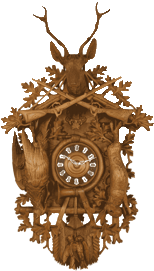Clockmaker tradition in the Black Forest
The Black Forest region has a long clockmaking tradition. As long ago as the mid 17th Century the locals, inspired by the bohemian clocks, began to produce the first clocks themselves. In the beginning these were simple and the mechanics were key. The good reputation of Black Forest clocks spread quickly and consequently the clock faces became more and more attractively finished. Due to the demand for the cuckoo clocks a successful move to the production of the clocks from home-production to factory production was possible.From the mid 19th Century large clock factories quickly became internationally famous. As well as the artistically finished Lackschilduhr, the so-called „Babywecker“ (baby alarm clock) - a round metal clock with a bell on top and decorative face - was also produced in high quantities (several million per year) and sold both abroad and in Germany. But also the so-called „Regulator“ (better known as the „Kastenuhr“, which by the beginning of the 20th Century hung in many living rooms) was made in the Black Forest. Additionally to these mentioned clocks, is the „Figurenuhr“ (figurine clock) typically from the Black Forest. The clocks, also called „Männleuhren“ by the locals are characterised by figurine movements, either every second or on every hour. They follow the concept of the cuckoo clock, but instead of a cuckoo call, a complete melody is performed by pipes or bells.
Even the radio clock became suitable for the mass market due to the Black Forest clockmakers: In the mid 1980s the first radio clocks were produced for office and living room for the Black Forest company Kundo-Staiger and Junghans. At the beginning of the nineties the first radio-controlled watch was created.


